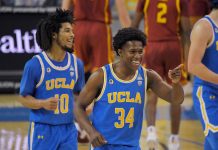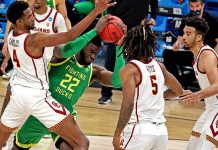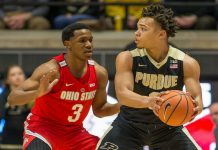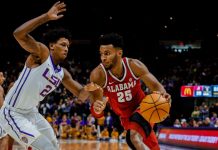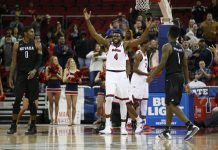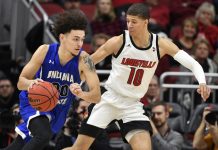LAWRENCE, Kan. (AP) Josh Jackson has been hearing people talk about his herky-jerky jump shot for years, ever since he was a hot young prospect with an elite combination of size, athleticism and natural scoring ability.
Then, the Kansas freshman started getting grief from his own teammates.
”I remember giving him a lot of crap this summer about him not being able to shoot,” said sophomore guard Devonte Graham, who has one of the sweetest strokes in college basketball.
”It was just, when he first came in and we were playing pick-up,” Graham continued, ”we were trying to get in his head. But I think that he got in the gym and started putting up shots, and it looks weird but it goes in, so I mean, I’m going to tell him to keep shooting.”
Jackson represents a unique paradox for high-level college basketball coaches.
On the one hand, the 6-foot-8 forward is likely to be a top-five pick in the NBA draft, if not the No. 1 selection. He’s capable of pouring in points by the dozen, his rebounding ability gives opposing teams fits, and his hustle makes him especially unique for a one-and-done player.
On the other hand, his shot would make just about any basketball coach cringe. It starts low, has a pronounced hitch on the way up, and the release point makes it look like he’s shooting from the hip.
Yet it usually goes in. So, do you allow Jackson to refine a shot that has generally worked so far, or do you risk wrecking everything to smooth it out in an effort to raise his ceiling even higher?
”To me it’s a little bit different getting to the, you know, setting it before he shoots it, but once he gets there, it’s as good as anybody else’s,” Jayhawks coach Bill Self said. ”It’s soft, and certainly he has improved it, but that’s going to be the question on him by a lot of people is can he be consistent. But I think he’s mechanically sound enough that he can be consistent.”
Self is hardly the only Division I coach to be forced into this predicament.
Perhaps the most infamous case in recent history is Michael Kidd-Gilchrest, whose shot was only a bit wonky when he arrived at Kentucky. The coaching staff tried to straighten things out and Kidd-Gilchrest kept getting more crooked, and by the time he was in the NBA, he looked like a corkscrew taking a shot.
Baylor has had to tweak several shots over the years, including Epke Udoh, who wound up being the sixth pick in the draft, and Quincy Acy, whose shot was so ugly that dunking was his only offense.
”If they are efficient at what they do, we’re not going to mess with them,” Baylor coach Scott Drew said. ”If it’s where they need major reconstruction, then we would rather do that than if someone’s a good shooter, try to tweak things to make them a great shooter, and now all of a sudden you make them an average shooter.”
Rico Gathers needed a full-blown reconstruction. The now-departed Baylor big man, Drew joked, still has the record for worst free-throw percentage in the history of the Peach Jam prep basketball tournament.
”There is a fine line,” Drew explained, ”and everybody knows there’s certain things you’re always going to want. You’re going to want them to hold their follow-through, you want them to have a good base.”
In short, it’s the BEEF method of shooting that most kids learn in elementary school: B for balance, E for eyes on the target, E for elbow straight and F for the follow-through.
But even if players start down the right path, it’s easy to go awry. Elite players tend to fall back on what feels most comfortable, particularly if they’re playing pick-up games or on the AAU circuit, where coaches might not hammer down on the details to keep things in line.
”My dad would always have the philosophy that once somebody gets into the ninth grade, if they love the game, you’re not going to be able to change their shot a whole lot,” said Arizona’s Sean Miller, whose father John is a Pennsylvania coaching icon. ”It’s really a crucial time to get the fundamentals straight.”
Because once they reach college, it is difficult to iron things out.
There are class demands. Social lives. And even when a player gets on the court, precious practice time is spent on scouting reports, running through offensive sets and implementing game plans.
There simply isn’t time to make wholesale changes to a player’s shot.
The best most coaches hope for are a few tweaks.
”We really try to focus on footwork,” Miller said. ”We have a number of freshmen right now that, if you watched them shoot every day, they have a really beautiful-looking shot. They can really shoot it. There will be a time when they will be excellent shooters. But in games, when there’s five-on-five and the ball’s moving and they move, they shoot three or four different ways. They are never on balance.
”What you can really change, and what they start to see, is the value of their footwork, where you want to shoot it the same way every time. If you have good balance, I think you improve as a shooter.”
That happens to be one of the things Jackson is working on at Kansas.
With help from assistant coach Kurtis Townsend, he’s been spending spare minutes in practicing refining his footwork, along with spreading his fingers on the ball to create a more solid base. The hope is that the subtle changes will improve the repeatability of his rather unorthodox shot.
”I can say I’ve received some really good tips in the past, and hopefully I’ll receive some in the future,” Jackson said. ”It’s really just muscle-memory, being comfortable and having confidence in it.”
—
AP Sports Writers John Marshall in Tucson, Arizona, and Stephen Hawkins in Waco, Texas, contributed to this report.
—
More AP college basketball: www.collegebasketball.ap.org and https://twitter.com/AP-Top25 .
25% Bonus via Western Union


